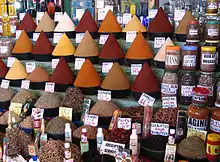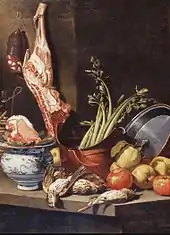Moroccan cuisine
Moroccan cuisine is influenced by Morocco's interactions and exchanges with other cultures and nations over the centuries.[1] Moroccan cuisine is usually a mix of Amazigh, Andalusian, and Mediterranean cuisines, with slight European (French and Spanish) and sub-Saharan influences.
 |
| This article is part of a series on |
| Moroccan cuisine |
|---|
| Related cuisine |
|


Ingredients
Morocco produces a large range of Mediterranean fruits, vegetables and even some tropical ones. Common meats include beef, goat, mutton and lamb, chicken and seafood, which serve as a base for the cuisine. Characteristic flavorings include lemon pickle, argan oil, cold-pressed, unrefined olive oil and dried fruits.[2] As in Mediterranean cuisine in general, the staple ingredients include wheat, used for bread and couscous, and olive oil; the third Mediterranean staple, the grape, is eaten as a dessert, though a certain amount of wine is made in the country.[3][4]
Flavorings

Spices are used extensively in Moroccan food. Although some spices have been imported to Morocco through the Arabs for thousands of years, many ingredients—like saffron from Talaouine, mint and olives from Meknes, and oranges and lemons from Fes—are home-grown, and are being exported. Common spices include cinnamon, cumin, turmeric, ginger, paprika, coriander, saffron, mace, cloves, fennel, anise, nutmeg, cayenne pepper, fenugreek, caraway, black pepper and sesame seeds. Twenty-seven spices are combined for the famous Moroccan spice mixture ras el hanout.[5]
Common herbs in Moroccan cuisine include mint, parsley, coriander, oregano, peppermint, marjoram, verbena, sage and bay laurel.
Structure of meals
A typical lunch meal begins with a series of hot and cold salads, followed by a tagine or Dwaz. Often, for a formal meal, a lamb or chicken dish is next, or couscous topped with meat and vegetables. Moroccans either eat with fork, knife and spoon or with their hands using bread as a utensil depending on the dish served. The consumption of pork and alcohol is uncommon due to religious restrictions.[6]
Main dishes
The main Moroccan dish most people are familiar with is couscous;[7] beef is the most commonly eaten red meat in Morocco, usually eaten in a tagine with a wide selection of vegetables. Chicken is also very commonly used in tagines or roasted. They also use additional ingredients such as plums, boiled eggs, and lemon. Like their national food, the tagine has a unique taste of popular spices such as saffron, cumin, cinnamon, ginger, and cilantro, as well as ground red pepper.[8]
Since Morocco lies on two coasts, the Atlantic and the Mediterranean, Moroccan cuisine has ample seafood dishes. European pilchard is caught in large but declining quantities.[9] Other fish species include mackerel, anchovy, sardinella, and horse mackerel.[10]
Other famous Moroccan dishes are Pastilla (also spelled Basteeya or Bestilla), Tanjia, and Rfissa.
A big part of the daily meal is bread. Bread in Morocco is principally made from durum wheat semolina known as khobz. Bakeries are very common throughout Morocco and fresh bread is a staple in every city, town, and village. The most common is whole grain coarse ground or white flour bread or baguettes. There are also a number of flat breads and pulled unleavened pan-fried breads.
In addition, there are dried salted meats and salted preserved meats such as khlea[11] and g'did (basically sheep bacon), which are used to flavor tagines or used in "el rghaif", a folded savory Moroccan pancake.
Soups
Harira, a typical heavy soup, eaten during winter to warm up and is usually served for dinner. It is typically eaten with plain bread or with dates during the month of Ramadan. Bissara is a broad bean-based soup that is also consumed during the colder months of the year.[12]

Salads
Salads include both raw and cooked vegetables, served either hot or cold.[13] Cold salads include zaalouk, an aubergine and tomato mixture, and taktouka (a mixture of tomatoes, smoked green peppers, garlic, and spices) characteristic of the cities of Taza and Fes, in the Atlas.[13] Another cold salad is called Bakoula, or Khoubiza. It consists of braised mallow leaves, but can also be made with spinach or arugula, with parsley, cilantro, lemon, olive oil, and olives.
Desserts
Usually, seasonal fruits rather than cooked desserts are served at the close of a meal. A common dessert is kaab el ghzal (كعب الغزال, gazelle ankles), a pastry stuffed with almond paste and topped with sugar. Another is "Halwa chebakia", pretzel-shaped dough deep-fried, soaked in honey and sprinkled with sesame seeds; it is eaten during the month of Ramadan. Jowhara is a delicacy typical of Fes, made with fried waraq pastry, cream, and toasted almond slices.[14] Coconut fudge cakes, 'Zucre Coco', are popular also.
Seafood
Morocco is endowed with over 3000 km of coastline. There is an abundance of fish in these coastal waters with the sardine being commercially significant as Morocco is the world's largest exporter.[15] Sardines were used in the production of garum in Lixus.
At Moroccan fish markets one can find sole, swordfish, tuna, tarbot, mackerel, shrimp, congre eel, skate, red snapper, spider crab, lobster and a variety of mollusks.
In Moroccan cuisine, seafood is incorporated into, among others: tajines, bastilla, Briouat and paella.

Drinks

The most popular drink is Moroccan mint tea. Traditionally, making good mint tea in Morocco is considered an art form and the drinking of it with friends and family is often a daily tradition. The pouring technique is as crucial as the quality of the tea itself. Moroccan tea pots have long, curved pouring spouts and this allows the tea to be poured evenly into tiny glasses from a height. For the best taste, glasses are filled in two stages. The Moroccans traditionally like tea with bubbles, so while pouring they hold the teapot high above the glasses. Finally, the tea is accompanied with hard sugar cones or lumps.[16] Morocco has an abundance of oranges and tangerines, so fresh orange juice is easily found freshly squeezed and is cheap.
Snacks and fast food
Selling fast food in the street has long been a tradition, and the best example is Djemaa el Fna square in Marrakech. Starting in the 1980s, new snack restaurants started serving "Bocadillo" (a Spanish word for a sandwich).
Dairy product shops locally called Mhlaba, are very prevalent all around the country. Those dairy stores generally offer all types of dairy products, juices, and local delicacies such as Bocadillos, Msemen and Harcha.[17]
Another popular street food in Morocco is the snails, which are served in their stew in small bowls and eaten using a toothpick.[18]
In the late 1990s, several multinational fast-food franchises opened restaurants in major cities.[19]
See also
References
- "The Art of Moroccan Cuisine".
- "An Introduction to Mediterranean Cuisine". TableAgent. Retrieved 28 April 2016.
- Jancis Robinson, ed. (2006). "Morocco". Oxford Companion to Wine (3rd ed.). Oxford: Oxford University Press. pp. 453–454. ISBN 0-19-860990-6.
- Moroccan wine and Muslims Archived 2008-06-09 at the Wayback Machine, Decanter 2008-06-06
- Otal, 1999, p. 3
- Food In Morocco. Food In Every Country. Accessed April 2011.
- "Moroccan Couscous Recipe". Maroccan Kitchen Recipes (Website). Accessed April 2014.
- "Food, Morocco Travel Guide" (PDF). Desert Morocco Adventure.
- Lanier, B. V. (1981). The World Supply and Demand Picture for Canned Small Pelagic Fish. Food & Agriculture Org. p. 15. ISBN 978-92-5-101143-0.
- "Moroccan Sardine FAO 34". Fishery Improvement Projects. Retrieved 10 May 2016.
- "klii"
- Valenta, Kyle (June 23, 2016). "How to eat breakfast like a local around the world - Provided By Advertising Publications". The Seattle Times. Retrieved September 6, 2016.
- Zeldes, Leah A. (Nov 11, 2009). "Eat this! Zaalouk, a cooked salad from Morocco". Dining Chicago. Chicago's Restaurant & Entertainment Guide. Retrieved Nov 12, 2009.
- "Traditional Moroccan Food | Moroccanzest". Moroccanzest. 2018-07-28. Retrieved 2018-11-05.
- "Moroccan Fishery Products Exports on the World Market" (PDF).
- Otal, 1999. p. 61
- "Dairy Development in Morocco" (PDF). Food and Agriculture Organization. Retrieved 10 May 2016.
- "Morocco Tastiest Street Food". Moroccanzest. 2018-09-03. Retrieved 2018-11-09.
- "Fast Food in Morocco". Euromonitor International. Retrieved 10 May 2016.
Further reading
Recipe books
- Connaître la cuisine marocaine, by Liliane Otal, Editions SudOuest, 1999 (in French). ISBN 978-2-879-01335-0
- Cooking at the Kasbah: Recipes from My Moroccan Kitchen, by Kitty Morse, Laurie Smith ISBN 0-8118-1503-X
- Couscous and Other Good Food from Morocco, by Paula Wolfert, Gael Greene ISBN 0-06-091396-7
- Cuisine des palais d'orient, by Alain Mordelet ISBN 2-87678-868-3
- Food of Morocco: Authentic Recipes from the North African Coast, by Fatema Hal ISBN 962-593-992-X
- Scent of Orange Blossoms: Sephardic Cuisine from Morocco, by Kitty Morse, Owen Morse ISBN 1-58008-269-6
- Traditional Moroccan Cooking: Recipes from Fez, by Madame Guinaudeau ISBN 1-897959-43-5
External links
| Wikimedia Commons has media related to Cuisine of Morocco. |


